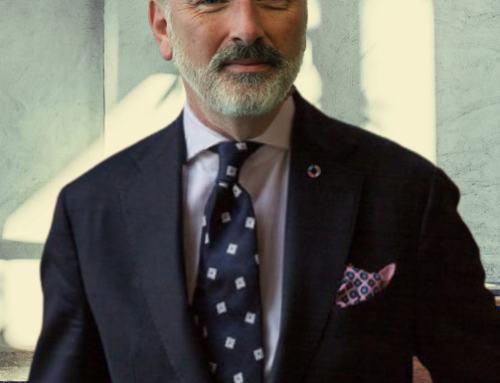How the Fusion of Ideas Can Save the World

When you hear the word ‘Apple’, what is the first thing that you think of? While some may think of the fruit, for many, and perhaps the majority, products such as iPhones, iPads and the iWatch may be the first that spring to mind. Thanks to one company’s application of cutting-edge technology into these transformative and iconic products, the name ‘Apple’ now has two distinct interpretations.
In some ways, this new interpretation of the name “Apple” mirrors the way in which the company’s groundbreaking successes actually have a much more interesting and nuanced history; one that ran in parallel to and predated the vision of Steve Jobs. In fact, the genealogy of many iconic Apple products can be traced back to a company called ‘General Magic’, that according to a 2018 documentary, was “The most important company that came out of Silicon Valley that nobody ever heard of”. It was in fact General Magic that designed the first smartphone and pioneered other modern technologies we now take for granted, such as touchscreens and emojis.
At their peak in the 1990’s, they were renowned for their moon-shot ideas, thinking that was outside the box and far in advance of any contemporary competition, with the aim of becoming the pioneers of what then led to many everyday technologies we now enjoy and take for granted.
In my opinion, the real reason General Magic’s story is so important is not their forward-thinking approach and their eventual vindication, but because theirs is a story of failure. While General Magic undoubtedly paved the way to the success of those who came later, at the time that foresight was ultimately incompatible with both the culture and technology that surrounded them. While they may have caught a glimpse of the future, their blindness to their present led to their demise.
What this story highlights is that failure today does not in fact mean the end, but rather the beginning. The beginning of a fusion of ideas which can have a seismic impact in the world of tomorrow.
Any great life-changing invention can be traced back to a fusion of such ideas over a period of time, a build-up of domain expertise, on a journey of discovery which is essential with any world-defining invention. The failure of General Magic and the success of Apple is just one story in a library that spans generations which show that more often than not, it is in fact the first followers and adopters of an idea that find great success, as opposed to its creator.
 My work over the past 15 years has been in philanthropy, particularly in the poor vision and the early childhood literacy space, and I believe essential lessons like these from the technology/venture capital industry can equally be applied in philanthropy and in trying to solve some of the world’s greatest social issues.
My work over the past 15 years has been in philanthropy, particularly in the poor vision and the early childhood literacy space, and I believe essential lessons like these from the technology/venture capital industry can equally be applied in philanthropy and in trying to solve some of the world’s greatest social issues.
The key underlying message to come out of this is the absolute importance of failure. Without failure, and without taking the risk associated with failure,
we would never be able to shift the dialogue on the issues we each seek out to resolve.
It is here that lies the unique and fundamental power and capability of philanthropic capital. This is because enlightened private philanthropists have the ability to take on the risks that institutions such as governments and long-standing businesses that are beholden to voters and shareholders respectively, cannot. They have the personal capital to fund the high risk, moon-shot ideas, in a way that social sector entrepreneurs also cannot. It is through financing these entrepreneurial out of the box ideas that catalytic social investors can patiently build their domain expertise: by learning what works and more importantly, what does not. It’s these lessons from failing ventures that eventually ensured ideas and proven solutions can further down the line, become mainstream winning stories. It is through this ability and process that catalytic social investors can strive to privatize failures and socialize their successes. Today, all social sector funding is commonly perceived by both doers and donors as equal in value. After all, a dollar is a dollar right?
However, if reframed with regard to potential impact this statement doesn’t reveal the whole truth. Institutional capital, where decisions are made by the agents and not the owners of capital naturally promotes a risk adverse mindset, as the agents need to justify their decisions to the actual owners. On the other hand- philanthropists, being themselves the owners of private capital, can afford to take high risks and accept failures in the name of the difficult journey that leads to system change if their domain expertise or passion for the cause is strong, as ultimately they need only justify their decisions to themselves.
Arguably, it is because of this that a dollar from a risk-taking catalytic social investor has much more potential, and therefore value than a dollar from an institutional funder. The conditions attached to funding from an enlightened philanthropic source is likely to be more flexible or less constraining to the entrepreneurial doer than institutional capital, as the expectations are not founded in immediate returns or considerations of accountability.
To put it into an analogy – risk taking capital to a doer is like fresh water to a sailor stuck in the middle of a saltwater sea. While there is a lot of water around you, drinking sea water to quench your thirst is counterproductive and may even be fatal.
Doers, like sailors in the ocean, have to be proactive and lucky to harvest fresh water because, at present, the conditions resemble a drought and the chance of rain is very low. If more private donors embrace taking risk and embark on their own journeys of system change and build the domain expertise to effect this change, the weather changes with the greater abundance of freshwater rain improving the odds of survival.
In other words, the current environment for these moon-shot ideas and life-changing solutions is dire. This is due to a distinct lack of fresh water (i.e. risk-taking capital) and an overabundance of saltwater (i.e. risk-averse capital). In stepping up and making more risk-taking capital available to the wider entrepreneurial community, private donors can use their position to more efficiently and quickly cause and create radical change and improve upon the systems that serve us today.
It is here where a fusion of ideas, and a fusion of risk-taking capital with entrepreneurial doers is crucial. As with General Magic and Apple, philanthropists that take those chances to provide the initial risk capital can generate new and exciting ideas. These ideas can then pave the way for other entrepreneurs or other institutions to evolve and adopt them, and in turn, these followers can then use these ideas to create groundbreaking global change that in the end benefits us all.
This is a challenging time for the planet in so many fields, and we must catalyze the vital changes needed and find the solutions to the crucial issues that, in more ways than one, plague us today. I believe philanthropists are central to this – and by taking moon-shots behind the scenes, we can get to the ideas and opportunities others will seize and transform into the defining solutions of tomorrow.
James Chen
Founder, Clearly
https://www.jameschen.vision/
Twitter: @James_Clearly
LinkedIn: @James Chen
How the Fusion of Ideas Can Save the World

When you hear the word ‘Apple’, what is the first thing that you think of? While some may think of the fruit, for many, and perhaps the majority, products such as iPhones, iPads and the iWatch may be the first that spring to mind. Thanks to one company’s application of cutting-edge technology into these transformative and iconic products, the name ‘Apple’ now has two distinct interpretations.
In some ways, this new interpretation of the name “Apple” mirrors the way in which the company’s groundbreaking successes actually have a much more interesting and nuanced history; one that ran in parallel to and predated the vision of Steve Jobs. In fact, the genealogy of many iconic Apple products can be traced back to a company called ‘General Magic’, that according to a 2018 documentary, was “The most important company that came out of Silicon Valley that nobody ever heard of”. It was in fact General Magic that designed the first smartphone and pioneered other modern technologies we now take for granted, such as touchscreens and emojis.
At their peak in the 1990’s, they were renowned for their moon-shot ideas, thinking that was outside the box and far in advance of any contemporary competition, with the aim of becoming the pioneers of what then led to many everyday technologies we now enjoy and take for granted.
In my opinion, the real reason General Magic’s story is so important is not their forward-thinking approach and their eventual vindication, but because theirs is a story of failure. While General Magic undoubtedly paved the way to the success of those who came later, at the time that foresight was ultimately incompatible with both the culture and technology that surrounded them. While they may have caught a glimpse of the future, their blindness to their present led to their demise.
What this story highlights is that failure today does not in fact mean the end, but rather the beginning. The beginning of a fusion of ideas which can have a seismic impact in the world of tomorrow.
Any great life-changing invention can be traced back to a fusion of such ideas over a period of time, a build-up of domain expertise, on a journey of discovery which is essential with any world-defining invention. The failure of General Magic and the success of Apple is just one story in a library that spans generations which show that more often than not, it is in fact the first followers and adopters of an idea that find great success, as opposed to its creator.
 My work over the past 15 years has been in philanthropy, particularly in the poor vision and the early childhood literacy space, and I believe essential lessons like these from the technology/venture capital industry can equally be applied in philanthropy and in trying to solve some of the world’s greatest social issues.
My work over the past 15 years has been in philanthropy, particularly in the poor vision and the early childhood literacy space, and I believe essential lessons like these from the technology/venture capital industry can equally be applied in philanthropy and in trying to solve some of the world’s greatest social issues.
The key underlying message to come out of this is the absolute importance of failure. Without failure, and without taking the risk associated with failure,
we would never be able to shift the dialogue on the issues we each seek out to resolve.
It is here that lies the unique and fundamental power and capability of philanthropic capital. This is because enlightened private philanthropists have the ability to take on the risks that institutions such as governments and long-standing businesses that are beholden to voters and shareholders respectively, cannot. They have the personal capital to fund the high risk, moon-shot ideas, in a way that social sector entrepreneurs also cannot. It is through financing these entrepreneurial out of the box ideas that catalytic social investors can patiently build their domain expertise: by learning what works and more importantly, what does not. It’s these lessons from failing ventures that eventually ensured ideas and proven solutions can further down the line, become mainstream winning stories. It is through this ability and process that catalytic social investors can strive to privatize failures and socialize their successes. Today, all social sector funding is commonly perceived by both doers and donors as equal in value. After all, a dollar is a dollar right?
However, if reframed with regard to potential impact this statement doesn’t reveal the whole truth. Institutional capital, where decisions are made by the agents and not the owners of capital naturally promotes a risk adverse mindset, as the agents need to justify their decisions to the actual owners. On the other hand- philanthropists, being themselves the owners of private capital, can afford to take high risks and accept failures in the name of the difficult journey that leads to system change if their domain expertise or passion for the cause is strong, as ultimately they need only justify their decisions to themselves.
Arguably, it is because of this that a dollar from a risk-taking catalytic social investor has much more potential, and therefore value than a dollar from an institutional funder. The conditions attached to funding from an enlightened philanthropic source is likely to be more flexible or less constraining to the entrepreneurial doer than institutional capital, as the expectations are not founded in immediate returns or considerations of accountability.
To put it into an analogy – risk taking capital to a doer is like fresh water to a sailor stuck in the middle of a saltwater sea. While there is a lot of water around you, drinking sea water to quench your thirst is counterproductive and may even be fatal.
Doers, like sailors in the ocean, have to be proactive and lucky to harvest fresh water because, at present, the conditions resemble a drought and the chance of rain is very low. If more private donors embrace taking risk and embark on their own journeys of system change and build the domain expertise to effect this change, the weather changes with the greater abundance of freshwater rain improving the odds of survival.
In other words, the current environment for these moon-shot ideas and life-changing solutions is dire. This is due to a distinct lack of fresh water (i.e. risk-taking capital) and an overabundance of saltwater (i.e. risk-averse capital). In stepping up and making more risk-taking capital available to the wider entrepreneurial community, private donors can use their position to more efficiently and quickly cause and create radical change and improve upon the systems that serve us today.
It is here where a fusion of ideas, and a fusion of risk-taking capital with entrepreneurial doers is crucial. As with General Magic and Apple, philanthropists that take those chances to provide the initial risk capital can generate new and exciting ideas. These ideas can then pave the way for other entrepreneurs or other institutions to evolve and adopt them, and in turn, these followers can then use these ideas to create groundbreaking global change that in the end benefits us all.
This is a challenging time for the planet in so many fields, and we must catalyze the vital changes needed and find the solutions to the crucial issues that, in more ways than one, plague us today. I believe philanthropists are central to this – and by taking moon-shots behind the scenes, we can get to the ideas and opportunities others will seize and transform into the defining solutions of tomorrow.
James Chen
Founder, Clearly
https://www.jameschen.vision/
Twitter: @James_Clearly
LinkedIn: @James Chen



